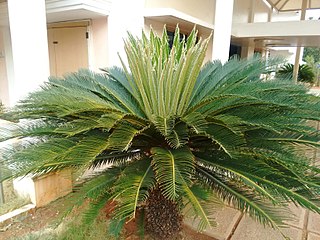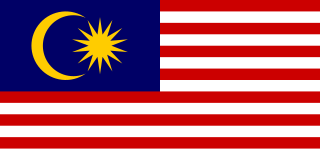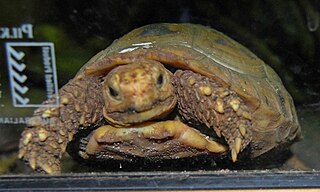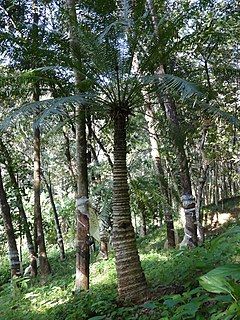
The Malay Peninsula is a peninsula in Southeast Asia. The land mass runs approximately north–south and, at its terminus, is the southernmost point of the Asian mainland. The area contains Peninsular Malaysia, Southern Thailand, and the southernmost tip of Myanmar (Kawthaung), as well as the city state of Singapore, indigenous to or historically inhabited by the Malays, an Austronesian people.

The geography of Malaysia deals with the physical and human geography of Malaysia, a Southeast Asian country. There are two major parts to this country, Peninsular Malaysia to the west and East Malaysia to the east. In addition, there are numerous smaller islands surrounding both landmasses. Peninsular Malaysia is situated on the southernmost section of the Malay Peninsula, south of Thailand, north of Singapore and east of the Indonesian island of Sumatra; East Malaysia comprises most of the northern part of Borneo island, with land borders shared with Brunei to the north and Indonesian Borneo which is to the south.

Cycas is a genus of plants belonging to a very ancient lineage, the Cycadophyta, which are not closely related to palms, ferns, trees or any other modern group of plants. They are evergreen perennials which achieved their maximum diversity in the Jurassic and Cretaceous periods, when they were distributed almost worldwide. At the end of the Cretaceous, when the non-avian dinosaurs became extinct, so did most of the cycas in the Northern Hemisphere.

Malaysia is a country in Southeast Asia. The federal constitutional monarchy consists of thirteen states and three federal territories, separated by the South China Sea into two regions, Peninsular Malaysia and Borneo's East Malaysia. Peninsular Malaysia shares a land and maritime border with Thailand and maritime borders with Singapore, Vietnam, and Indonesia. East Malaysia shares land and maritime borders with Brunei and Indonesia and a maritime border with the Philippines and Vietnam. Kuala Lumpur is the national capital and largest city while Putrajaya is the seat of the federal government. With a population of over 32 million, Malaysia is the world's 43rd-most populous country. The southernmost point of continental Eurasia is in Tanjung Piai. In the tropics, Malaysia is one of 17 megadiverse countries, home to a number of endemic species.

Bukit Larut is a hill resort in Malaysia located in the state of Perak, Malaysia, 10 kilometres southwest from Taiping. It was established under the direction of British colonists in 1884 as a place of observation for tin mining activity and as a retreat for the English people who were based in nearby Larut and Taiping. The area was initially named Maxwell Hill after the British Malaya administrator George Maxwell, and was renamed as Bukit Larut in 1979.

Nepenthes macfarlanei is a carnivorous pitcher plant species endemic to Peninsular Malaysia. It produces attractive red-speckled pitchers. Lower pitchers are ovoid or infundibular in the lower half and globose or cylindrical above and up to 25 cm high. Upper (aerial) pitchers are of a lighter colour with wings reduced to rubs. The lower surface of the lid is densely covered with short, white hairs. This is a characteristic morphological feature of this species, but at present its function is unknown.

Nepenthes benstonei is a tropical pitcher plant endemic to Peninsular Malaysia, where it grows at elevations of 150–1350 m above sea level. The specific epithet benstonei honours botanist Benjamin Clemens Stone, who was one of the first to collect the species.

Nepenthes ramispina is a highland Nepenthes pitcher plant species, native to Peninsular Malaysia. It was once regarded as being similar to N. gracillima, but studies of the two species in nature have shown that they are readily distinguishable in isolation, N. gracillima being far more readily confused with N. macfarlanei in its rosette stage.

The Malayan civet, also known as the Malay civet and Oriental civet, is a viverrid native to the Malay Peninsula and the islands of Sumatra, Bangka, Borneo, the Riau Archipelago, and the Philippines. It is listed as "Least Concern" by IUCN as it is a relatively widely distributed, appears to be tolerant of degraded habitats, and occurs in a number of protected areas.

Indotestudo is a genus of tortoise from South and Southeast Asia. in the family Testudinidae. The three species in the genus are all threatened.

Cycas circinalis, also known as the queen sago, is a species of cycad known in the wild only from southern India. Cycas circinalis is the only gymnosperm species found among native Sri Lankan flora.

The Malayan tailless leaf-nosed bat is a species of bat in the family Hipposideridae. It is a very small bat which has long and soft fur. The fur coloration is brown to blackish on the dorsal surface and ashy on the ventral surface. It can be distinguished from the other roundleaf bats by its small size and the absence of the tail. It is listed as vulnerable by the IUCN
Heliciopsis cockburnii is a species of plant in the family Proteaceae. It is a tree endemic to Peninsular Malaysia. It is threatened by habitat loss.
Heliciopsis rufidula is a species of plant in the family Proteaceae. It is a tree found in Peninsular Malaysia and Borneo. It is threatened by habitat loss.
Heliciopsis whitmorei is a species of plant in the family Proteaceae. It is a tree endemic to Peninsular Malaysia. It is threatened by habitat loss.

The environment of Malaysia is the biotas and geologies that constitute the natural environment of Malaysia. Malaysia's ecology is megadiverse, with a biodiverse range of flora and fauna found in various ecoregions throughout the country. Tropical rainforests encompass between 59% to 70% of Malaysia's total land area, of which 11.6% is pristine. Malaysia has the world's fifth largest mangrove area, which totals over a half a million hectares.

Peninsular Malaysia, also known as Malaya or West Malaysia, is the part of Malaysia which occupies the southern half of the Malay Peninsula and the surrounding islands. Its area totals 132,265 km2 (51,068 sq mi), which is nearly 40% of the total area of the country; the other 60% is East Malaysia. For comparison, it is slightly larger than England (130,395 km²). It shares a land border with Thailand to the north.

Nepenthes of Sumatra and Peninsular Malaysia is a monograph by Charles Clarke on the tropical pitcher plants of Sumatra, Peninsular Malaysia, and their minor surrounding islands. It was published in 2001 by Natural History Publications (Borneo). Clarke described it as "intermediate between an ecological monograph and a taxonomic one".
Cycas clivicola is a species of cycad in Thailand, Cambodia, Vietnam, and Malaysia. It is found on limestone outcrops, as well as on offshore islands.
Cycas macrocarpa is a species of cycad in Malaysia and Thailand.














